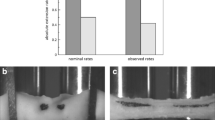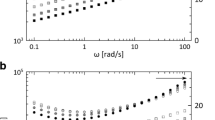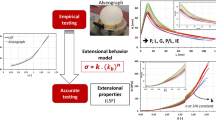Abstract
Glutens were isolated from flour of three European wheat cultivars which perform differently in cereal products. The rheological and fracture properties of gluten-water doughs were determined in uniaxial and biaxial extension at large deformations and small angle sinusoidal oscillation tests and compared with the mechanical properties of the parental flour doughs. At 25 °C the linear region was in the same range as that of flour dough, while at a higher temperature (45 °C) the linear region was more than an order of magnitude higher. At 45 °C the storage modulus and tan δ were lower than at 25 °C. Variation in moduli between cultivars was much more pronounced for gluten than for flour doughs.
Similarly to flour dough in both uniaxial and biaxial extension the stress (σ) increased more than proportionally with the strain, a phenomenon called strain hardening. The stress at a set strain and strain hardening depended much more strongly on the type of deformation for gluten than for flour dough: σ was higher in biaxial extension for gluten than for flour dough, but was much higher in uniaxial extension. This indicates that orientational effects in elongational flow are of even larger importance for the mechanical properties of gluten than of flour dough. It is likely that it is the glutenin fraction that, because of its large size, confers these direction dependent properties to gluten and flour doughs. Fracture stresses were much higher for gluten than for flour dough, while fracture strains were in the same range or higher. For gluten dough fracture strains increased less strongly with increasing strain rate than for flour dough. Glutens exhibiting a higher stress at a certain strain had a smaller fracture strain.
Our findings confirm the conviction that the large deformation properties of flour dough are mainly governed by the gluten fraction. However, there are also differences. Compared to flour dough gluten dough exhibits (i) a stronger strain hardening, (ii) a larger difference in σ between uniaxial and biaxial extension and (iii) a smaller strain rate dependency of the fracture strain.








Similar content being viewed by others
References
American Association of Cereal Chemists (1983) Approved methods of the AACC, 8th edn. Method 44-19. The Association: St. Paul, MN
American Association of Cereal Chemists (2000) Approved methods of the AACC, 10th edn. Method 54-40A. The Association, St. Paul, MN
Belton PS (1999) On the elasticity of wheat gluten. J Cereal Sci 29:103–107
Bloksma AH (1990) Dough structure, dough rheology and baking quality. Cereal Foods World 35:237–244
Bloksma AH, Isings J (1957) A note on the birefringence of stretched gluten. Cereal Chem 34:137–139
Cornec M, Popineau Y, Lefebvre J (1994) Characterisation of gluten subfractions by SE-HPLC and dynamic rheological analysis in shear. J Cereal Sci 19:131–139
Dhanasekharan M, Wang CF, Kokini JL (2001) Use of nonlinear differential viscoelastic models to predict the rheological properties of gluten dough. J Food Process Eng 24:193–216
Dunnewind B, Grolle K, Sliwinski EL, van Vliet T (2003) Uniaxial extension of wheat flour dough using the Kieffer Extensibility Rig. J Texture Stud (in press)
Ewart JAD (1977) Re-examination of the linear gluten hypothesis. J Sci Food Agric 28:191–199
Gras PW, Andersson RS, Keentok M, Békés F, Appels R (2001) Gluten protein functionality in wheat flour processing: a review. Aust J Agric Res 52:1311–1323
Hoseney RC, Rogers DE (1990) The formation and properties of wheat flour doughs. Crit Rev Food Sci Nutrition 29:73–93
Janssen AM, van Vliet T, Vereijken JM (1996a) Rheological behaviour of wheat glutens at small and large deformations. Comparison of two glutens differing in bread making potential. J Cereal Sci 23:19–31
Janssen AM, van Vliet T, Vereijken JM (1996b) Rheological behaviour of wheat glutens at small and large deformations. Effect of gluten composition. J Cereal Sci 23:33–42
Khatkar BS, Bell AE, Schofield JD (1995) The dynamic rheological properties of gluten and gluten subfractions from wheats of good and poor breadmaking quality. J Cereal Sci 22:29–44
Kieffer R, Kim JJ, Belitz HD (1981) Zugversuche mit weizenkleber im micromaßstab. Z Lebensm Unters Forsch 172:190–192
Kim JJ, Kieffer R, Belitz HD (1988) Rheological properties of wheat gluten, containing different amounts of prolamins from various cereals. Z Lebensm Unters Forsch 186:16–21
Kokelaar JJ, van Vliet T, Prins A (1996) Strain hardening properties and extensibility of flour and gluten doughs in relation to breadmaking performance. J Cereal Sci 24:199–214
Larsson H, Eliasson A-C (1996) Phase separation of wheat flour dough studied by ultracentrifugation and stress relaxation. II. Influence of mixing time, ascorbic acid, and lipids. Cereal Chem 73(1):25–31
Lefebvre J, Popineau Y, Cornec M (1994) Viscoelastic properties of gluten proteins: influence of prolamin composition and temperature. In: Gluten proteins. Association of Cereal Research, pp 180–189
Lindborg KM, Trägårdh C, Eliasson A-C, Delmek P (1997) Time-resolved shear viscosity of wheat flour doughs. Effect of mixing, shear rate, and resting on the viscosity of doughs of different flours. Cereal Chem 74:49–55
Meissner J (1997) Rheology and rheometry of viscoelastic liquids. In: Windhab J, Wolf B (eds) Proceedings 1st International Symposium on Food Rheology and Structure. ETH, Zurich, p 27–36
Phan-Thien N, Safari-Ardi M, Morales-Patino A (1997) Oscillatory and simple shear flows of a flour-water dough: a constitutive model. Rheol Acta 36:38–48
Rinde JA, Tschoegl NW, Smith TL (1970) Large-deformation and rupture properties of wheat flour gluten. J Sci Food Agric 47:225–235
Roels S (1997) Factors governing wheat and wheat gluten functionality in breadmaking and gluten/starch separation. Thesis, Catholic University Leuven, Belgium
Rouillé J, Della valle G, Lefebvre J, Sliwinski EL, van Vliet T (2002) The role of minor components in shear and extensional viscosities of wheat flour dough. In: Proceedings of the 6th European Conference on Rheology, Erlangen, Germany, pp 323–324
Schofield RK, Scott-Blair GW (1937) The relationship between viscosity, elasticity and plastic strength of a soft material as illustrated by some mechanical properties of flour dough. IV. The separate contributions of gluten and starch. Proc R Soc (London) 160A:87
Schweizer T, Conde-Petit B (1997) Bread dough elongation. In: Windhab J, Wolf B (eds) Proceedings of 1st International Symposium on Food Rheology and Structure, ETH, Zurich, pp 391–394
Shewry RS, Popineau Y, Lafiandra D, Belton P (2001) Wheat glutenin subunits and dough elasticity: findings of the EUROWHEAT project. Trends Food Sci Technol 11:433–441
Shogren MD, Finney KF, Hoseney RC (1969) Functional (breadmaking) and biochemical properties of wheat flour components. I. Solubilizing gluten and flour protein. Cereal Chem 46(2):93–102
Singh H, MacRitchie F (2001) Application of polymer science to properties of gluten. J Cereal Sci 33:231–243
Slade L, Levine H, Finley JW (1989) Protein-water interactions: water as a plasticizer of gluten and other protein polymers. In: Philips RD, Finley JE (eds) Protein quality and the effects of processing. Marcel Dekker, New York, pp 9–123
Sliwinski EL, Kolster P, van Vliet T (2003a) Large deformation properties of wheat dough in uni and biaxial extension. Part I. Flour dough. Rheol Acta (in press)
Sliwinski EL, Kolster P, van Vliet T (2003b) On the relationship between baking quality and rheological properties of wheat flour dough. J Cereal Sci (in press)
Sliwinski EL, Sreeramulu G, Cohen-Stuart M, Vereijken JM (2003c) Physicochemical properties of subfractions from Glenlea and Hereward wheat gluten. Manuscript in preparation
Smith JR, Smith TL, Tschoegl NW (1970) Rheological properties of wheat flour doughs. III. Dynamic shear modulus and its dependence on amplitude, frequency and dough composition. Rheol Acta 9:239–252
Tatham ST, Hayes L, Shewry PR, Urry DW (2001) Wheat seed proteins exhibit a complex mechanism of protein elasticity. Biochem Biophys Acta 1548:187–193
Tschoegl NW, Rinde JA, Smith TL (1970) Rheological properties of wheat flour doughs. 1. Method for determining the large deformation and rupture properties in simple tension. J Sci Food Agric 21:65–70
Tsiami AA, Bot A, Agterof WGM, Groot RD (1997a) Rheological properties of glutenin subfractions in relation to their molecular weight. J Cereal Sci 26:15–27
Tsiami AA, Bot A, Agterof WGM (1997b) Rheology of mixtures of glutenin subfractions. J Cereal Sci 26:279–287
Uthayakumaran S, Newberry M, Phan-Tien N, Tanner R (2002) Small and large strain rheology of wheat gluten. Rheol Acta 41:162–172
Van Vliet T, Janssen AM, Bloksma AH, Walstra P (1992) Strain hardening of dough as a requirement for gas retention. J Texture Stud 23:439–460
Van Vliet T, Luyten H, Walstra P (1995) Time dependent fracture behaviour of food. In: Dickinson E (ed) Food polymers, gels and colloids. Royal Society of Chemistry, Cambridge, pp 175–190
Wahlund KG, Gustavsson M, MacRitchie F, Nylander T, Wannerberger L (1996) Size characterisation of wheat proteins, particularly glutenin, by asymmetrical flow field-flow fractionation. J Cereal Sci 73(4):499–505
Wang CF, Kokini JL (1995) Prediction of the nonlinear viscoelastic properties of gluten doughs. J Food Eng 25:297–309
Wrigley CW (1996) Giant proteins with flour power. Nature 381:738–739
Zheng H, Morgenstern MP, Campanella OH, Larsen NG (2000) Rheological properties of dough during mechanical dough development. J Cereal Sci 32:293–306
Acknowledgements
The authors wish to thank Meneba Meel BV in Rotterdam for providing and milling the wheat. They would also like to thank A. Prins and W. Kloek for providing useful comments and suggestions to improve the manuscript. The skilful practical assistance of Cristina Martinez San Martin is gratefully acknowledged. This research was supported financially by the ministry of Economical Affairs under contract no IOP-IE 92013.
Author information
Authors and Affiliations
Corresponding author
Rights and permissions
About this article
Cite this article
Sliwinski, E.L., van der Hoef, F., Kolster, P. et al. Large-deformation properties of wheat dough in uni- and biaxial extension. Part II. Gluten dough. Rheol Acta 43, 321–332 (2004). https://doi.org/10.1007/s00397-003-0345-4
Received:
Accepted:
Published:
Issue Date:
DOI: https://doi.org/10.1007/s00397-003-0345-4




